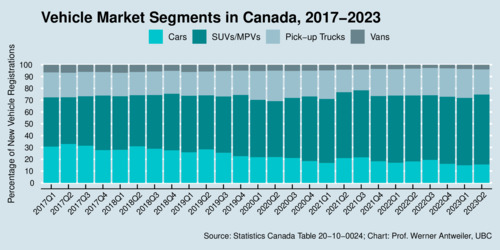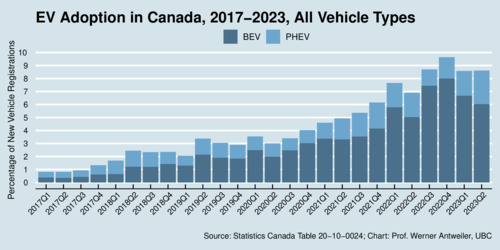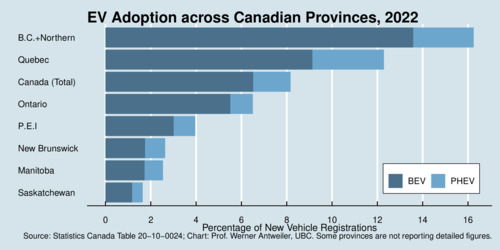In one of my recent blogs I explored the state of EV adoption around the world and BC's evolving ZEV laws. You may have wondered what the trends are in Canada over time and across provinces. I have three new charts to tell a story. The first chart is actually about the evolution of vehicle segments over the last five years, and it reveals a continuing trend away from ordinary passenger cars to heavier multi-purpose vehicles (MPVs), a class that includes sports-utility vehicles (SUVs) and cross-overs. This trend towards heavier vehicles makes the transition to EVs somewhat more challenging than in Europe because heavier vehicles need bigger batteries for driving the same range. And bigger batteries make vehicles more expensive.

click on image for high-resolution PDF version
The second chart shows the adoption of electric vehicles (EVs) by quarter, as reported by Statistics Canada Table 20-10-0024-01. The chart shows the share of battery electric vehicles (BEVs) and plug-in hybrid electric vehicles (PHEVs) relative to the total number of new vehicle registrations. During the last quarter of 2022, the EV adoption rate approached but did not cross 10%.

click on image for high-resolution PDF version
The national picture hides stark differences across provinces. Estimates for Newfoundland and Labrador, Nova Scotia and Alberta are not available because of contractual limitations of the existing data sharing agreement that Statistics Canada has with these provinces. However, registration data from these provinces are included in the Canadian total. Estimate for for British Columbia include the three Northern Territories.
Throughout 2022, EV adoption was highest in British Columbia, followed by Quebec. These two provinces both have clean and cheap electricity, combined with major urban agglomerations. Both of these factors support higher EV uptake. Ontario is a distant third, and EV adoption across the prairies and in Atlantic Canada is low. Roughly 9 out of 10 new EVs are registered in BC, Quebec and Ontario.

click on image for high-resolution PDF version
What does this uneven adoption rate tell us about the future? What will it take to electrify mobility across Canada? The data tells us that electrification is easier where (a) electricity is cheap, (b) there is high population density with relatively shorter commutes, (c) local governments work towards lowering adoption barriers such EV charging infrastructure and are providing EV purchase incentives, and (d) there is greater concern about climate change. The latter point was made by a recent Leger survey about attitudes towards extreme weather events, which revealed a strong urban-rural gradient. The federal government has yet to announce detailed regulations for its ZEV mandate (which requires transition to EVs by 2035 for new vehicles), so there remains some uncertainty about the stringency of the policy. The ZEV mandate apparently has enjoyed cross-party political support and is likely to remain in place regardless of electoral outcomes in the next federal election.
![[Sauder School of Business]](logo-ubc-sauder-2016.png)
![[The University of British Columbia]](logo-ubc-2016.png)